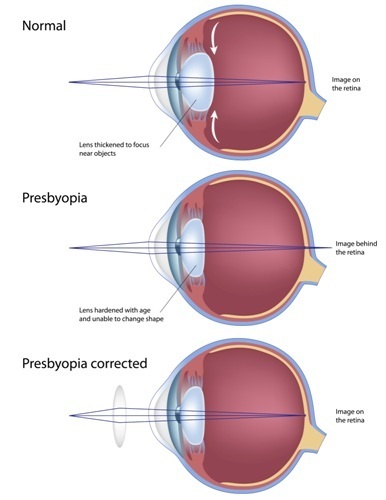Do you need to wear reading glasses whenever you look at your phone or read a book? Many people rely on reading glasses to see things that are right in front of them.
You have to carry them around with you, or else it becomes difficult to do things as simple as reading a menu at a restaurant. If it seems like everyone around you uses reading glasses, it’s because of an age-related condition called presbyopia.
Presbyopia is also known as age-related farsightedness. However, reading glasses are not the only treatment.
If you have presbyopia, you don’t have to be stuck with them for the rest of your life. There is another way to see things clearly in front of you without using reading glasses.
Keep reading to discover why you don’t have to live with reading glasses forever!
What is Presbyopia?

Presbyopia is an age-related eye condition that affects your ability to focus on nearby objects. If you have presbyopia, you may start noticing it in your forties or fifties.
Presbyopia gradually worsens as you get older. It’s also one of the most common eye conditions and affects 1.8 billion people worldwide.
As you age, the natural lens in your eye loses its flexibility. It can no longer change shape to focus on nearby objects when it becomes rigid.
If your lens is too rigid, it makes things directly in front of you appear blurry, while faraway objects can remain clear and easier to see. The primary symptom of presbyopia is experiencing blurry vision at a normal reading distance.
You may squint if you try to look at things right in front of you or close up. These may include things like a newspaper or computer screen. You may also find that using additional light becomes necessary or that you experience eye strain and headaches.
Many people find reading easier when they hold things an arm’s length away. Symptoms of presbyopia can also worsen if you’re tired.
How are Presbyopia and Cataracts Different?

Although both presbyopia and cataracts affect the natural lens, they are not the same thing. Cataracts occur when the natural lens becomes cloudy due to proteins building up on the lens.
These proteins impact your ability to see clearly and turn the lens yellow or brown. Presbyopia occurs when the natural lens loses flexibility and makes it more challenging to see things in front of you.
However, what you may not know is that you can have cataracts and presbyopia at the same time. You may think you have presbyopia when you have cataracts or vice versa.
You may also have both and not realize it, making diagnosing the cause of your vision problems more difficult. The most significant risk factor for developing presbyopia is age.
Almost everyone will experience presbyopia at some point as they get older. However, other factors can increase your risk, including conditions like anemia and diabetes, medications like antidepressants and antihistamines, and sustaining an eye injury. Being farsighted can put you at a higher risk as well.
How Can Refractive Lens Exchange Help Treat Presbyopia?

Reading glasses are often the first method of coping with presbyopia, but having to wear glasses any time you want to look at something up close is less than ideal. Fortunately, a procedure called refractive lens exchange (RLE) can help.
RLE is a procedure that replaces the natural lens of your eye with an artificial one. This new lens is called an intraocular lens, or IOL.
This IOL contains the lens power you need to treat presbyopia permanently. If refractive lens exchange sounds almost identical to cataract surgery, it’s because it is.
Both procedures replace your natural lens with an artificial lens to allow you to see clearly. However, while cataract surgery aims to remove cloudiness from your vision, the purpose of RLE is to eliminate the need for visual aids.
Like cataract surgery, getting refractive lens exchange is an outpatient procedure. First, Dr. Dell at Dell Laser Consultants will use drops to numb your eyes.
He will then create a tiny incision in your cornea to remove your lens. After making the incision, he will implant your IOL.
The entire process can take as little as fifteen minutes. After it’s in place, you won’t be able to see or feel the lens.
How well you can see after RLE depends on which IOL you have implanted. At Dell Laser Consultants, we are proud to offer Full Focus® lenses for your greatest range of clear vision.
With Full Focus® lenses, RLE can allow you to see near, far, and anywhere in between. Many patients who get refractive lens exchange no longer need to rely on their reading glasses to see daily.
Reduce Your Dependence on Reading Glasses

You can reduce your dependence on glasses or contacts when looking at any distance. Having an IOL will allow you to see clearly at any distance, especially when you choose a Full Focus® lens. Many patients find that they can give up their reading glasses for good.
RLE is usually performed on patients who are 40 or older. While it’s great for patients without cataracts, it can also benefit those with a cataract in its early stages. Choosing to have refractive lens exchange before a cataract has fully developed means we can stop it from progressing.
In addition to clear vision, one significant benefit of refractive lens exchange is that you won’t have to worry about a cataract developing in the future. A cataract cannot form on an IOL. When you have refractive lens exchange, you can look forward to decades of clear vision without cataracts.
Are you tired of having to rely on reading glasses? You don’t have to wear them forever.
Find out if you’re a good candidate for a procedure like refractive lens exchange by scheduling your consultation at Dell Laser Consultants in Austin, TX, today!





